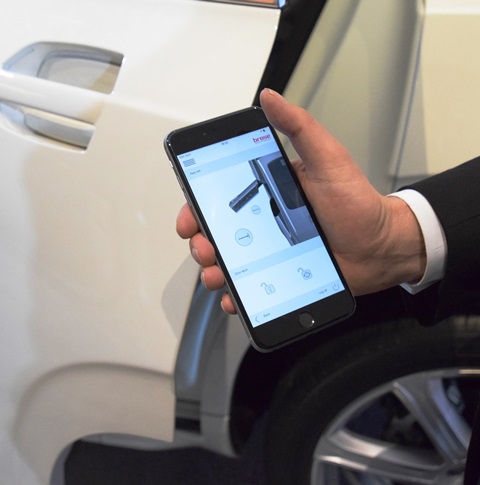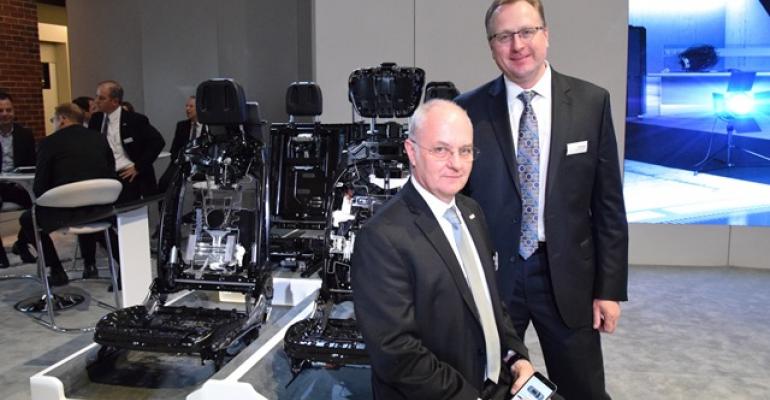Window regulators, door latches and seat frames may sound like simple commodity automotive products, but advanced concepts being shopped to automakers by Brose seem downright sexy.
With expertise in mechatronics, the family-owned German supplier also manufactures motors for climate-control blowers, cooling fans, drivetrain actuators and electric braking systems. Europe’s No.1 supplier of power seat adjusters has 23,000 employees at 60 locations in 23 countries generating annual sales of about €5.2 billion ($5.8 billion).
A lot of the revenue stems from mechanical parts that have been core to Brose’s portfolio for decades. The company launched the manual window regulator in 1928, the mechanical door latch in 1950 and the power window regulator in 1962.
Today, these components are being reinvented to improve comfort, convenience and safety. For instance, a smartphone can be used to electrically open conventionally hinged car doors, and a button inside can be pushed to close them. Sensors will prevent the doors from closing on hands.
The Rolls-Royce Wraith coupe currently has two rear-hinged power closing doors, but they cannot be controlled with a smartphone.

The seat frame can be integrated with massaging functions that also can be turned up or down via smartphone or tablet. Tired of that awkward reach behind your left shoulder for the seatbelt when buckling up in a coupe? Brose engineers have developed a seat frame that twists up to 3 ins. (7.6 cm), making it much easier to grab the seatbelt.
Here’s an idea car thieves will hate but designers will love: disappearing door handles. An owner leaving his vehicle can use a smartphone to trigger two flaps that deploy, covering the space above and below the door handle. For better aerodynamics, the flaps also can remain deployed while the vehicle is moving. Tesla uses similar disappearing handles on its Model S.
In the emerging age of car sharing, smartphone apps will be available allowing a person’s height, favorite music and preferred cabin temperature and seat adjustment to be in place when a person takes possession of a vehicle.
“You will walk up with your phone. The car will recognize it’s you, and everything adjusts to you,” says Michael Brosseau, president of Brose North America, during a recent demonstration of the technologies.
“Even though it’s not your car, when you walk up, it becomes your car.”
Anti-Pinch Windows and Auto Liftgates
Anti-pinch power windows have been around for years, but only those that sense resistance from an object in its path when closing. At that point the window will open. The technology has been heralded by consumer advocates for preventing children from being choked by a closing window.
Brose’s next-generation window uses a capacitive sensor strip along the top edge of the window that senses moisture from the skin but never needs to actually touch the skin before backing off.
A hand that comes within 2 ins. (5 cm) of a window while it is closing will trigger it to reverse course, says Carsten Brandt, Brose’s director of development-seat systems.
“It’s the first non-touchable anti-trap window,” he says. “You can see it’s really working in every situation. You don’t need to touch it.”

The technology is not yet ready for production, and the supplier is seeking ways to make it more cost-competitive with conventional anti-pinch windows.
Power folding third-row seats currently are available, and Brose now also proposes power folding second-row seats to create a flat load floor in a large SUV. The supplier manufactures seat frames for the new Volvo XC90, and Brandt says his company will provide the next-generation vehicle with electric folding seats in both rows.
With so many potential seat configurations in a 7-passenger vehicle, Brandt demonstrates how a tablet or smartphone can be programmed with multiple 1-touch options. For instance “soccer mode” could have all seats up while “ski mode” could lower second- and third-row seats on the passenger side.
Brose also supplies Volvo with the automatic liftgate, which will open if a person with the keyfob waves a foot underneath the rear bumper. The feature gained popularity when it arrived on the Ford Escape in 2011, and now the technology is appearing on a growing number of vehicles.
Brose pioneered the feature and holds a majority of the market globally.
Cargo Canopy and Hoods That Barely Open
A few new ideas from Brose are fun to ponder but doubtful to be in production in the near future.
The first is a cargo isolation concept that cinches down objects such as a briefcase or groceries. Located in the cargo hold of a utility vehicle or minivan, the device looks like a canopy, supported by four flexible pillars that stretch nearly to the ceiling. A person places goods on the cargo floor, closes the liftgate and the pillars collapse into the floor, pulling down the mesh canopy until it’s tight over whatever needs to be held in place.

Until a clever name comes along, Brose is calling the technology “automatic load fixation.” About 4 ins. (10 cm) is necessary in the cargo floor so the flexible pillars can retract and stow.
Finally, Brose offers a technology that is ideal for people who never want to pop the hood; they do it grudgingly to fill the windshield wiper fluid. Otherwise, the car goes to the mechanic for oil changes and other maintenance.
Still, automakers invest in plastic “beauty covers” that sit atop the engine and add a design element but also are expensive and add weight.
Brose’s solution is a hood that opens only a matter of inches, just wide enough for a small filler neck to present itself, conveniently placed near the fender so the wiper fluid can be topped off.
Engineering departments test the market with far-out ideas such as these. “We want to see if we are going in the right direction,” Brosseau says.
“It doesn’t all make it to production, but we show them what we can do,” he says. “A lot of times you get, ‘I wouldn’t do that with it, but can you do this with it.’ This is where new ideas come from.”
Business has been brisk. Even during the downturn in 2008 and 2009, Brose maintained staff and paid bonuses.
The company is expanding globally, with plans for five new facilities. In Taicang, China, Brose is building its largest plant, with an estimated 600 employees producing seat systems and motor drives beginning in 2018. In Shenyang, China, the company plans to open a plant in first-quarter 2017, with 50 employees manufacturing lightweight carriers for BMW.
Next month in Bamberg, Germany, Brose expects about 600 employees in corporate purchasing, information systems and central development to occupy new offices. In Prievidza, Slovakia, the company expects to start production at a new plant next year of electric motors and drives, liftgate systems and window regulators for multiple automakers. Employment is expected to reach 600 within the first five years.
In Querétaro, Mexico, Brose plans to manufacture seats beginning next year at what will be its largest North American plant, eventually employing 800 people within five years.
In southeast Michigan, Brose acquired a massive service parts warehouse from Fiat Chrysler in New Boston in 2012, and Brosseau was convinced the supplier would never fill it.
But within a few years, the space is near capacity, producing seat structures, door modules and electric motors for Ford, FCA, Honda, Nissan, Magna, Lear, Recaro and Faurecia.




